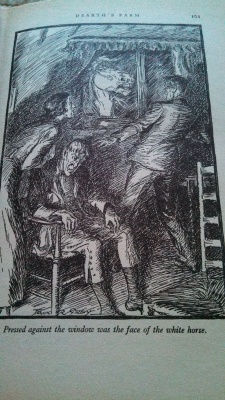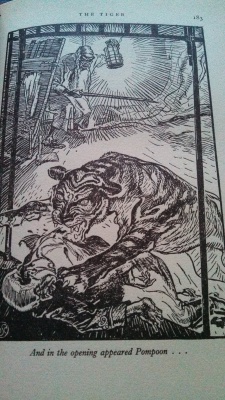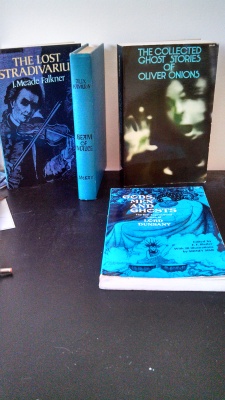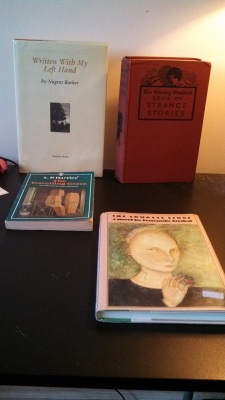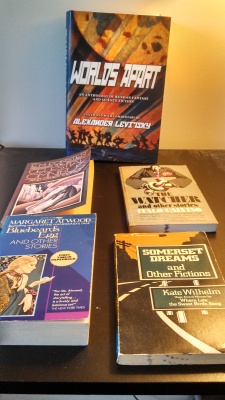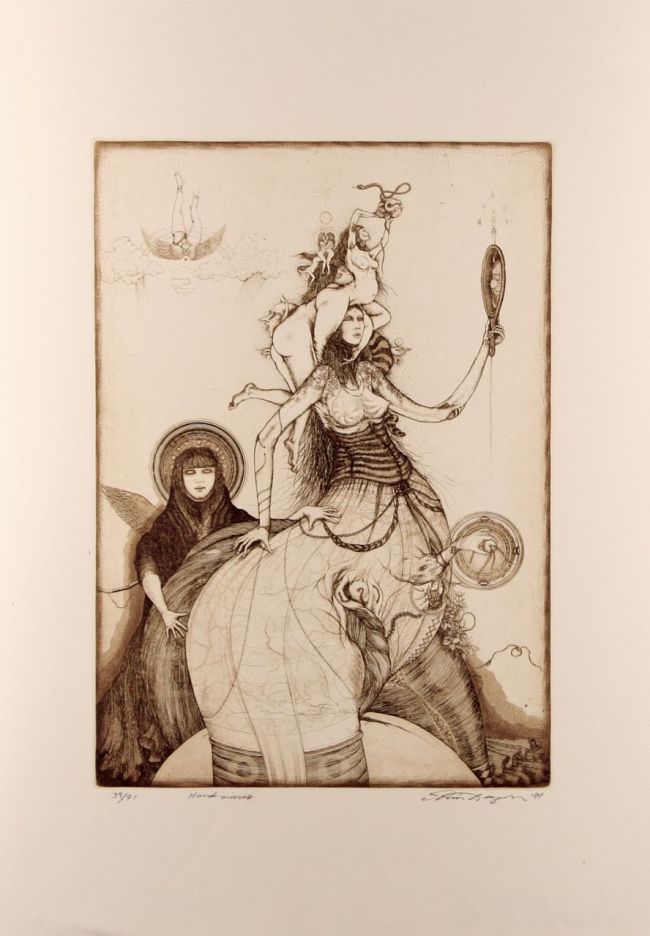
Roy Friberg. Title, date n/a.
I first encountered the work of John Davys Beresford (1873-1947) in Alberto Manguel’s stunning anthology Black Water 2: More Tales of the Fantastic. The piece of fiction Manguel chose for inclusion was “The Misanthrope,” from Beresford’s 1918 collection Nineteen Impressions. “The Misanthrope” had been included previously in a Dorothy Sayers anthology (The Omnibus of Crime) as well as the uncredited Evening Standard Book of Strange Stories from 1934. I read it and was hooked. The tale had that tantalizing combination of the ambiguous and gruesome so much excellent British strange fiction had from the period. I wrote the story down, graded it in my notebook, and filed the name away in my mind. It stayed there for awhile, inert.
Since then I’ve read several more instances of Beresford’s work, including the puzzling “Powers of the Air,” from an old hardback Thrillers anthology from the 40’s, with a golden bat embossed on the bruise-purple cover, and fragrant pages that smelled like every shelf-haunter’s wet (or dry?) dream. I came across “A Negligible Experiment” in one of S.T. Joshi’s weird anthologies. With these three stories in my crap filing cabinet of a mind, I eventually decided to find a copy of Nineteen Impressions. There was a print on demand edition available for about five dollars from Aegypan Press, and I picked it up.
What I realized from reading the slim collection is that only three of the nineteen impressions were worth reading. “The Misanthrope” was one, and “Powers of the Air” was the second. The third was called “The Little Town,” and after reading I wondered if it wasn’t the best of the three.
Beresford writes an introduction entitled “The Other Thing” for Impressions, and it is worth quoting because it is revealing of the aesthetics and ideology of not only Beresford, but many other writers of this type of fiction:
“At the moment we receive it, we respond without reservation. For a time we believe that we, too, have had a vision of the other thing. And, then, it is as if the tiny opening had drawn together again, and we find – an explanation. Nothing in the world is more depressing than an explanation. It is like dull, drab paint on what was once a shining surface. It hides the mystery of those half-seen depths that do reflect something, even if we cannot see clearly what the image is.”
This echoes similar statements made by writers as different as Borges and Sacheverell Sitwell. Several odd comparisons come to mind, such as John Keat’s “science kills the rainbow” wangst and the Iowa School Imposing Edifice of Realist Fiction’s injunction to “show, not tell.” And yet while there is some connection between the former to Beresford’s obvious resistance to scientific hegemony and materialism, this particular aesthetic has survived to enjoy employment by authors and readers of decidedly materialist bent. It also goes beyond the standard “it is better to imagine the monster than to reveal it” technique of much old-fashioned horror, and into a more extreme realm of obfuscation which has always seemed new to me, the opposite of old-fashioned.
At its dizzying height, this aesthetic and its associated techniques verge on the avant-garde, they thumb their noses at absolutist readings while providing plenty of material to chew on (in opposition to Joanna Russ’ idea that an exemplar of this style, Robert Aickman, was essentially empty, nothing but a vampiric style draining the corpses of succulent stories). Instead of providing cheese and crackers for a single interpretation, they provide a feast of material, almost an excess. It is, to put it in simplistic terms, the application of modernist (and also, in a lesser way, surrealist) thought to a very traditional medium, arriving at its own tradition: the strange story. (That this is more of a strange story than a weird story is a taxonomic quibble worth noting, but not enough to prevent me from including it as a “neglected weird fiction.”)
“The Little Town” does not quite reach the heights of the best of this style or order of fiction, but it approaches it. It begins with a nameless and genderless narrator on a night train to an English town called St. Erth, occulted in the hillside, unknown to even the most knowledgeable. (Beresford makes clear it is not the St. Erth in Cornwall, but another one elsewhere). This description of the passenger looking out the window of the train provides an example of Beresford’s clear prose, shining with concision and observation:
The yellow lighted reflection of the now familiar interior jutted out before me, its floor diaphanous and traversed by two streaks of shining metal. And my own white face peered in at me with strained, searching eyes, frowning at me when our glances met, trying to peer past me into the light and warmth of the railway carriage.
One of the techniques marshaled by this somber, every-button-buttoned surrealism is: The Detail Noticed by the Narrator that Couldn’t Possibly Be True. In the classical ghost story, this effect served as the first incrementalist note in a gradually building symphony of generic cohesion. Or to put it in less shitty and cumbersome terms, as the foreshadowing and build up. It was a road that took the reader to a fictional locale that had both Latitude and Longitude readings available. But applied here, it is a road that tends to lead to a bush snarled dead end, or to the meeting of disused train tracks. It still coheres to generic terms, but its own generic terms, the primary dictum of which is that not all doors that are opened must be closed. This technique is given its first go on the first page, when the narrator notices that the train is crossing a bridge over a body of water that, to his knowledge, does not exist and could not exist. “We were not near the sea and no English river could surely have been so wide.”
The narrator arrives at the terminus and heads to the night’s lodgings. He (one is tempted to say he, the narrator seems so much an emanation of Beresford himself) eats dinner and decides to explore what he has been told is “quite a small place.” The narrator heads out into the dark and finds that the street the inn is on leads downhill. Lamps occasionally dot the darkness as the narrator passes recessed courtyards and alleys, out of which come sparse laughter and conversation. Bodies flit by his, indifferent, along the constantly descending “tedious ravel of streets.”

Ludwig Sievert, stage design for The Dead City, 1921.
I turned at last out of a passage so narrow that my body brushed the wall on either side, into a small square of low houses and the floor of the square was flat. On all sides it was entered by passages such as that from which I had just emerged, and all of them led upwards. About and above me I could vaguely distinguish an infinite slope of houses, ranging up tier above tier, lost at last in the black immensity. I appeared to be at the bottom of some Titanic basin among the mountains; at the center of some inconceivably vast collection of mean houses that swarmed over the whole face of visible earth.
This is on the third page! Most of the stories in Nineteen Impressions are under six pages, and this tale is no exception. After marveling at the ascension of St Erth’s streets, the narrator ends up in front of a building with an open door and a faded sign reading “Kosmos.” He passes through a proscenium opening onto a lit theater stage and a small cluster of people waiting in shadow.
I found a seat near the door and waited. It came to me that the stage was disproportionately large for the size of the hall. And then out of the wings came wobbling a tiny figure, and I realized that this great stage was set for a puppet-show. The whole thing was so impossibly grotesque, that I nearly laughed aloud.
Again, that building strangeness which has no resolution. How or why the stage seems unaccountably large we will never see. What follows from this introduction of the puppet show reminds me of a miniaturized version of Kafka’s “Josephine,” in its psychological analysis and portrait of the effect of artistic performance on a group. It is brilliant. The whole performance is an inscrutable exercise in senility, feebleness, and graphic meaninglessness. In a more overtly sinister aspect, our nameless and sexless narrator becomes perplexed that they cannot discern the presence of wires connecting the puppets to their manipulator above the stage. They seem to be moving of their own (demented) accord. Abruptly, the curtains close over the stage while the puppets continue moving. The lights turn out. The watchers get up to leave and return to the interminable streets of St. Erth.
At the closing of the show, our emanation of J.D. Beresford decides to mount a staircase in order to discover who in the preposterous hell put on such an ineffective and disquieting puppet show. He discovers an old man, in a chair so large it is “almost a throne.” The man has a gentle and benevolent look on his face as he commands the dolls with his hands and seems never disturbed when they fall or stumble under his care. The wires connecting his fingers to the dolls below remain invisible. Perturbed, the narrator leaves to walk back to his lodgings. On the return trip the town seems to have diminished in size and the walk takes only ten minutes.
An obvious symbolism presents itself in “Erth” and “Kosmos,” but Beresford himself rejects this interpretation in his introduction, saying, “If I had said that the old man up in the flies of the Kosmos Theater represented God, I should have grossly satirized my own idea.” If taken to be true (and why not, for the sake of argument) this would provide another technique marshaled by strange fiction: that of throwing out red herrings as if a mystery tale were being written.
In distinction to Beresford’s point of view, I do not actually mind that interpretation of the “The Little Town.” It has a pre-vision of Thomas Ligotti about it, and shades of David Park Barnitz’s decadent collection of verse, The Book of Jade (1901). The final line in particular reminds me of Barnitz’s invective against god as a “filthy idiot” sitting in a pile of his own shit and playing with it: “I wondered whether he was a charlatan or only very old, and very, very foolish.”
Another interpretation is perhaps that, like the foolish old man, we all imagine we are in control of our lives, and deny assiduously that our motions to control it are in fact doing nothing at all. I highly recommend all four Beresford stories mentioned here, and both Nineteen Impressions and his later collection Signs and Wonders are available as abominable print on demand editions.
* * * * *
As a post-script I would like to further quote Beresford for the sake of a relevant comment on tendencies in weird and strange fiction: “Nor can I find [the other thing] by reading the careful mysteries of those who write of fauns and naiads; the stories of those authors who appear to think that mystery died, if not with ancient Greece, at least in the Middle Ages. Indeed, I think that when we are reduced to seeking this other thing in the past, we have lost our ability to find it.” Hello, pastiches of gas-light detection and M.R. James!
I will couple this with Fredric Jameson, from “Magical narratives,” as quoted in Rosemary Jackson’s Fantasy: The Literature of Subversion: “For when we speak of a mode, what can we mean but that this particular literary discourse is not bound to the conventions of a given age, nor indissolubly linked to a given type of verbal artifact, but rather persists as a temptation and a mode of expression across a whole range of historical periods, seeming to offer itself, if only intermittently, as a formal possibility which can be revived and renewed.”
Is such fiction existent now as a formal possibility to be renewed? Or do we mistake a garden of dying cabbage for a manicured pleasure park, replete with moats and cottage?













